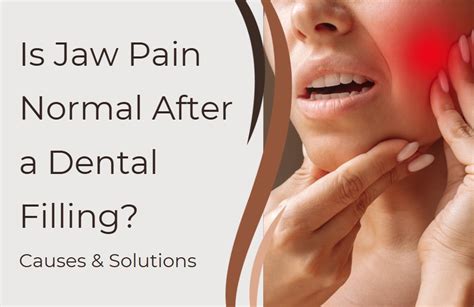Jaw Pain After Dental Filling

Jaw pain after receiving a dental filling is a relatively common complaint, with a multitude of potential causes. The pain can range from mild to severe and may be temporary or persist for a longer period. Understanding the reasons behind this discomfort can help alleviate concerns and guide individuals towards the appropriate course of action to seek relief.
One of the primary reasons for jaw pain following a dental filling is the process of the tooth being prepared for the filling itself. During this preparation, the dentist must remove decayed portions of the tooth, which may involve drilling. This process can sometimes cause irritation to the pulp of the tooth or the surrounding bone and gum tissues, leading to pain. The extent of the pain often depends on the depth of the decay and the amount of tooth structure that needs to be removed.
Another significant factor contributing to jaw pain is the material used for the filling. Traditional amalgam fillings, for example, expand and contract with temperature changes in the mouth, which can sometimes cause slight discomfort or sensitivity. However, with the advancement in dental technology, newer materials like composite resin are designed to have a lower thermal conductivity, potentially reducing the risk of sensitivity and associated jaw pain. Despite these advancements, some individuals may still experience discomfort due to the filling material.
The occlusion, or the way the upper and lower teeth come into contact with each other, also plays a crucial role in jaw pain after dental fillings. If the filling is not properly shaped or if it alters the bite in such a way that it puts additional stress on the jaw joint (temporomandibular joint, TMJ) and the surrounding muscles, it can lead to discomfort and pain. This type of pain may not only be localized to the jaw but can also radiate to the face, temples, and even the ears.
Furthermore, the trauma caused by the dental procedure itself can be a source of jaw pain. This is especially true if the mouth was kept open for an extended period, causing strain on the jaw muscles. The use of dental instruments, particularly if they are not carefully managed, can also inadvertently cause injury to the jaw or the TMJ, resulting in pain.
In addition to these factors, anxiety or stress related to the dental procedure can exacerbate perceived pain levels. Individuals who experience high levels of anxiety during dental visits may report higher levels of discomfort post-procedure, including jaw pain, even when the procedure itself went smoothly and without complication.
To manage jaw pain after a dental filling, several steps can be taken. Applying a cold compress to the outside of the cheek near the affected area can help reduce swelling and ease pain. Over-the-counter pain relievers, such as ibuprofen or acetaminophen, can be effective in managing discomfort. However, it’s crucial to follow the dentist’s advice on pain management, as they can prescribe stronger pain medication if necessary or recommend alternative therapies.
If the pain persists or is severe, it’s essential to return to the dentist for an evaluation. The dentist may need to adjust the filling, especially if the pain is related to the occlusion or if the filling is placing undue stress on the jaw and surrounding structures. In some cases, additional treatments such as a bite adjustment, physical therapy for the jaw muscles, or even a referral to a specialist like an oral surgeon or an orthodontist may be necessary.
Preventive measures can also play a significant role in minimizing the risk of jaw pain after dental fillings. Regular dental check-ups can help identify decay early, potentially reducing the need for extensive fillings. Practicing good oral hygiene, including brushing and flossing, can prevent the progression of decay and reduce the risk of complications during dental procedures.
In conclusion, jaw pain following a dental filling is a complex issue with multiple potential causes, ranging from the procedure’s technical aspects to individual patient factors. By recognizing these causes and taking proactive steps towards management and prevention, individuals can better ensure a smooth and comfortable recovery from dental procedures.
What are common causes of jaw pain after a dental filling?
+Jaw pain after a dental filling can be caused by the preparation of the tooth for the filling, the filling material itself, alterations in occlusion, trauma from the procedure, and anxiety or stress related to the dental visit.
How can I manage jaw pain after a dental filling?
+Managing jaw pain after a dental filling involves applying a cold compress, using over-the-counter pain relievers as advised by the dentist, and returning to the dentist for an evaluation if the pain persists or is severe.
Can jaw pain after a dental filling be prevented?
+While not entirely preventable, the risk of jaw pain after a dental filling can be minimized by practicing good oral hygiene, attending regular dental check-ups to identify decay early, and following the dentist’s advice on post-procedure care.